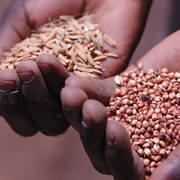4th Post: At the Nepalese Demonstration Farms
27.09.2013
A thing you might notice in Nepal is although all motorcycle drivers wear a helmet, the person riding with them never does. Yaron, a Glocal program MA student from HUJI who is involved in our project, inquired why and came back with an answer: it's simply illegal. Only the driver is allowed to wear a helmet here, and if the person riding along will also put one on he will be fined. This law came about by the need to reduce motorcycle related crime. A couple of guys on a motorcycle, hidden and unidentifiable by their helmets, robbing a place and taking off was a common incident. So they took away one of the two helmets. No helmet no problem; and the rest is history (of head injuries).
 Anyway, I have spent the week in the field, and am now back in Kathmandu (where I can easily find a bed and my size to sleep in; not so much in the village), Ramechhap and the surrounding vicinity are beautiful this time of year, right after the rainy season. All is greener and somewhat feels more alive. The visibility is great and on certain days you could even see the Himalayas in the horizon.
Anyway, I have spent the week in the field, and am now back in Kathmandu (where I can easily find a bed and my size to sleep in; not so much in the village), Ramechhap and the surrounding vicinity are beautiful this time of year, right after the rainy season. All is greener and somewhat feels more alive. The visibility is great and on certain days you could even see the Himalayas in the horizon.
Matan and I, among other things, checked out the two demonstration farms that are to serve as the main training grounds for the local farmers. There, training in organic farming will take place. Farmers will learn how to improve their current crop cycles, use natural pesticides and fertilizers, and how to build and operate nurseries and mini-greenhouses. In addition, various techniques for growing off-season vegetables will be introduced, and effort will be put into trying to grow crops that aren't traditionally being grown in the region, such as wheat.
Local farmers will come to train at these demonstration farms (on the left you can see me with Bijay, the agricultural coordinator of the area, at one of he farms) and in additional smaller satellite farms, and will also receive routine visits by agricultural technicians, in their own private fields. At the moment, due to poor conditions, lack of irrigation sources, and limited knowledge, many households do not grow enough to sustain themselves. Even when local farmers are able to cultivate and produce beyond their needs, trading the surplus is not an easy thing. There are local bazaars but vehicles cannot get to the region during most of the year, and products are being brought in and out through a narrow pedestrians' bridge crossing the river. You can see the villagers sometimes carry sacks of grain first by foot and then on local buses or jeeps when on the other side of that bridge. Yesterday, when we were traveling back to Kathmandu, a woman from one of the villages also traveling somewhere out of Ramechhap, brought with her a full grown live chicken in a small plastic bag.
 Now in Kathmandu, we have a few more days of tying up some lose ends and finalizing certain aspects of the research, while data is being already collected by the survey team in the field. These guys are working hard, going from house to house in a difficult terrain, filling up hour and a half long questionnaires. In a week from now they'll be done and we will carry on with a preliminary analysis of the survey data.
Now in Kathmandu, we have a few more days of tying up some lose ends and finalizing certain aspects of the research, while data is being already collected by the survey team in the field. These guys are working hard, going from house to house in a difficult terrain, filling up hour and a half long questionnaires. In a week from now they'll be done and we will carry on with a preliminary analysis of the survey data.
Yannay




